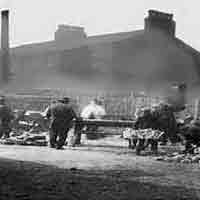The English workhouse system for the destitute

From the time of the 1834 Victorian Poor Law Amendment Act to around the 1930s, there were three parts to the system of support for people in England who were too poor to support themselves and their families. The workhouse is the best known and is often used loosely to group the three parts together. This page looks at the three parts of the system and the how they were administered.
____
By the webmaster's mother (1906-2002) from personal observations and discussions with her father who was a workhouse labour master and her uncle who chaired the local Board of Guardians which oversaw the local workhouse system, edited with further research by the webmaster
The three parts of the workhouse system of support
'Pauper' is a word that we don't hear in Britain today, but in the past it was well-known. It was applied to any individual who had no means of support, and there was a dreadful stigma to it. There was a system of support for these people, but there was equally a dreadful stigma to having to use it. This support was in the following three parts:
• The workhouse
The workhouse is the best known of the three types of support in the larger workhouse system. It was somewhere to live for local people who couldn't support themselves. Sometimes whole families had to go into the workhouse if the wage earner could no longer work. It is important to stress the words local and live because the other two categories are for a different set of individuals - see below:
Workhouse inmates had to work for their keep, and their living conditions were harsh. In many ways it was like being in prison, except that they were encouraged to find and take up paid work outside and leave.
The infirmary was for the local and poverty stricken aged and infirm. It was like a very basic hospital and was either for short-term residents while they recovered or for those who were unlikely to live long. The infirmary at, for example, Southwell was on the top floor of the workhouse building, but in Edmonton it was in a separate building on the same site.
• The casual ward
The casual ward was for poverty-stricken individuals who were not local and had no home-parish to support them. They were allowed to stay for one night only, and then had to find their way to a casual ward in another area. Normally they had to walk, which gave rise to their name of tramps.
The origin of the workhouse system: The English Poor Laws
The workhouse system that my mother saw as a child was set up in all three of its forms under the Victorian 1834 Poor Law Amendment Act. This made it the formal responsibility of local parishes to provide support for the poor. It developed out of late-medieval and Tudor-era laws.
The Poor Laws were not limited to care of the destitute living. The destitute dead could also be buried by the parish, but there was a dreadful stigma to it, just as there was to having to go into a workhouse.
Costs of the workhouse system
The costs or running the workhouse system were borne by the local parish, the equivalent of today's local council. Clearly there was no way for the destitute inmates to contribute and equally clearly it was in the interests of the parish to keep the costs as low as possible with as few inmates as possible. Hence the basic nature of everything supplied to inmates and the harshness of the life there.
Management and staffing
Boards of guardians
Every workhouse was under the management of a Board of Guardians and funded by the local parish. For many years, my uncle was the chairman of our Edmonton Board of Guardians. My mother learnt a lot from him.
Labour masters
The day-to-day manager of the staff was called a labour master. Usually there were several, working in shifts. At one time my father was a labour master at Edmonton, and my mother learnt a lot from him too.
Tramp majors
The tramp major was the casual ward equivalent of the labour master. Whether or not this was the formal title is uncertain since tramps were formally known as vagrants not tramps.
Other staff
My mother didn't remember her father or uncle mentioning other staff. There were presumably nurses and a doctor on call at the infirmary, but we suspected that the main caring work was done by the female inmates. They certainly did the cooking and cleaning.
The end of the workhouse system
In 1930 the last workhouses were officially closed, marking the end of the Poor Law system. However they continued in some form until the establishment of the welfare state, just after the Second World War.
| sources | webmaster | contact |
Text and images are copyright
If you can add anything to this page or provide a photo, please contact me.



